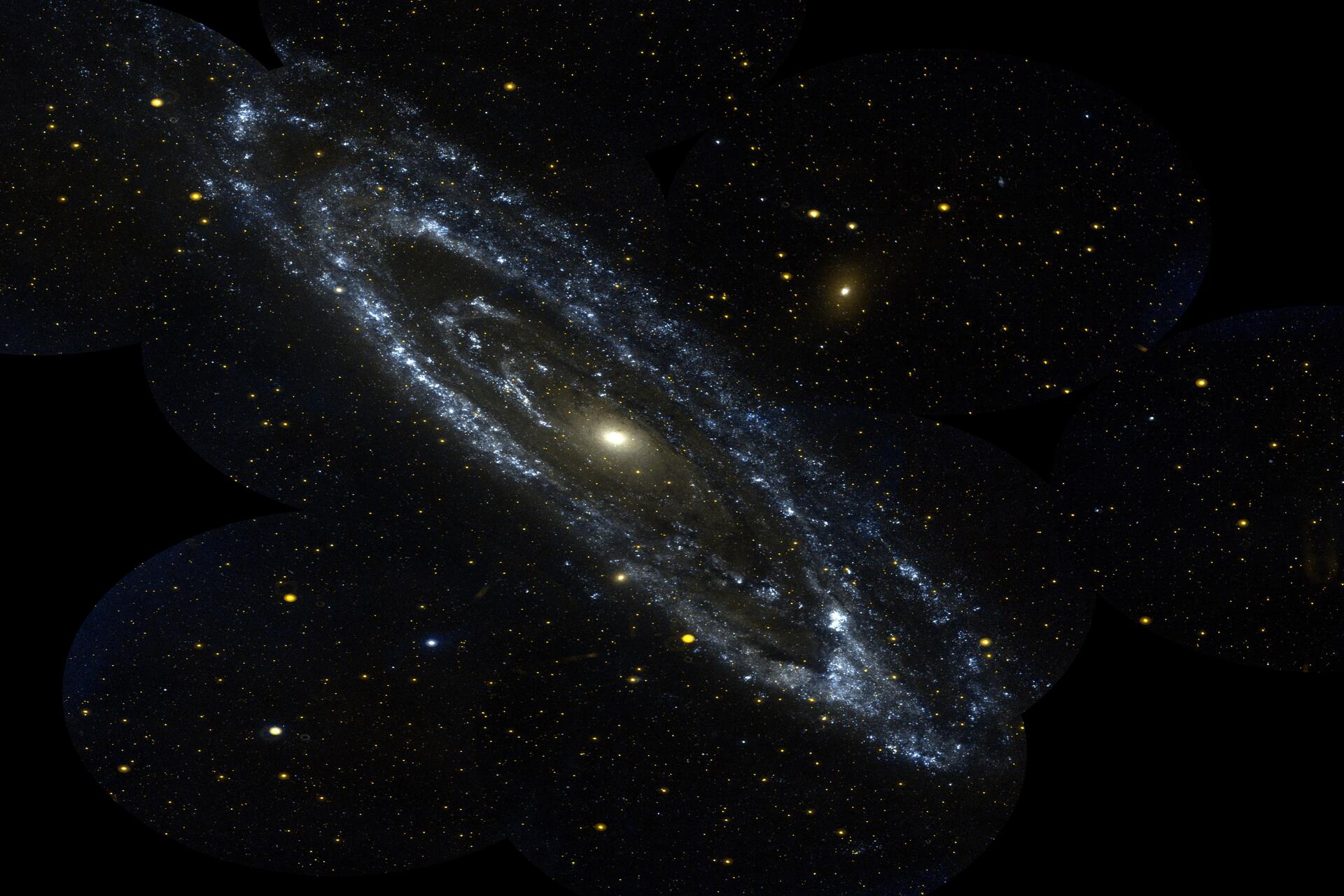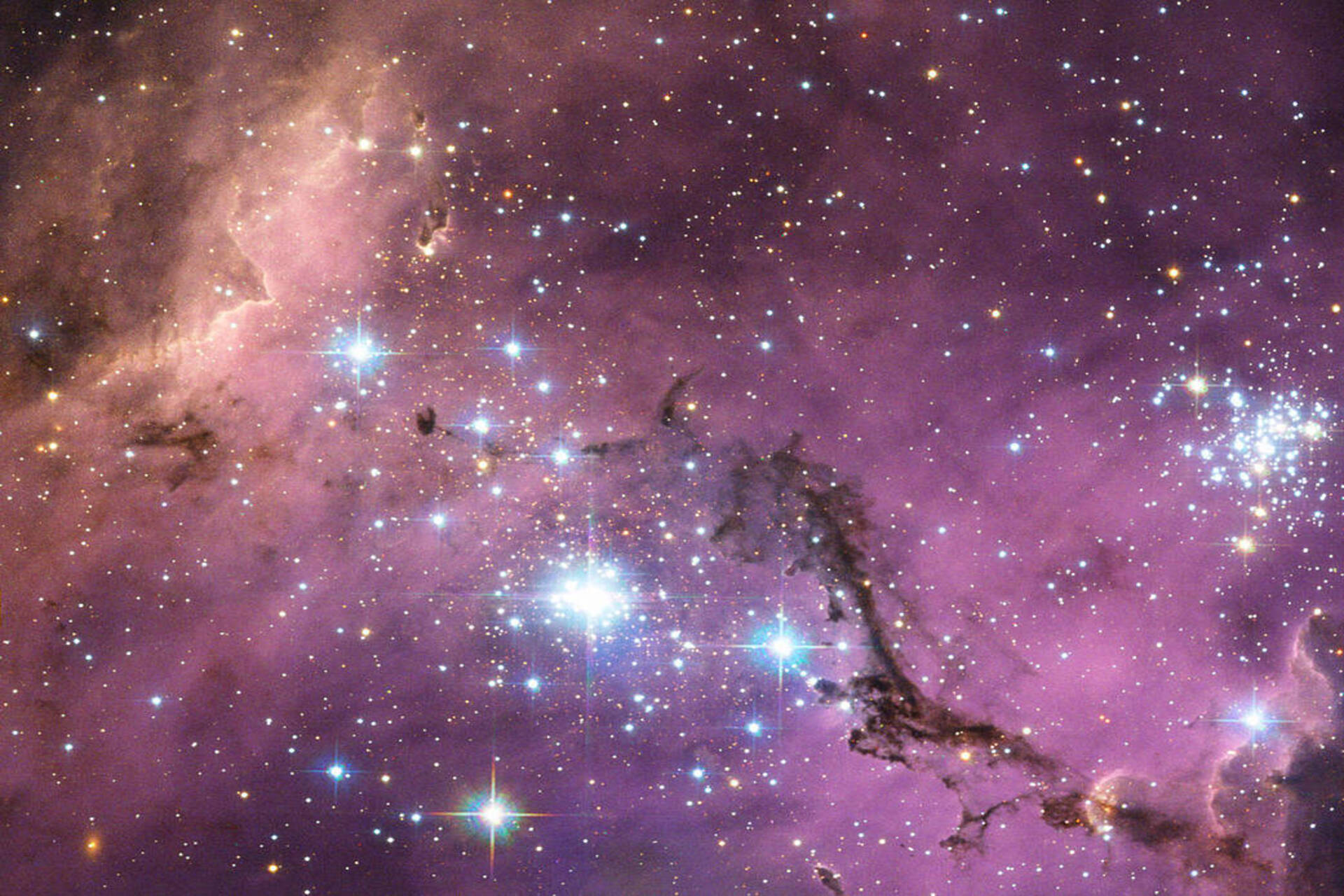Stardust and Eternity – 3.4.2
Andromeda and the Other Galaxies
The Milky Way, our galaxy, is only one of billions or even trillions of galaxies in our Universe. Galaxies are immense gravitationally bound systems, composed of up to trillions of stars and interspersed with dust and gas. Unlike stars, only a few galaxies can be observed in the Northern Hemisphere without a telescope. Among these galaxies, the most important is Andromeda, also known as M31 in the Messier Catalogue. Similarly to the Milky Way, Andromeda is a barred “spiral galaxy”. However, it is also about twice its size and it is located in the constellation of Andromeda. Being our nearest large neighbour – as far as about 2.5 million light-years from Earth – it can be visible to the naked eye from Earth on moonless nights, just below the W-shaped constellation of Cassiopeia, from areas with moderate light pollution. Around 4.5 billion years from now, the Andromeda galaxy is expected to collide and eventually merge with the Milky Way due to its proper motion. As a result, a new giant elliptical galaxy will form, aptly named “Milkomeda”.
Other peculiar galaxies that can be easily observed from Earth are the Large and Small Magellanic Clouds. They are visible with the naked eye in the Southern Hemisphere at night. These two small – or “dwarf” – galaxies are actually “satellite galaxies” orbiting the Milky Way. Like Andromeda, they belong to the so-called “Local group” – a cluster of galaxy formed at least by 80 members, most of which are dwarf galaxies. Clusters of galaxies such as the Local Group are organized into larger groups called “superclusters”, the largest structures in the universe (hundreds of millions of light-years in size). The Local Group is part of the Virgo Supercluster.
In past centuries, astronomers observed galaxies as faint nebulous patches of light. They did not know they were actually separated from the Milky Way. Some of them were also listed by Charles Messier (1730–1817) in his catalogue and were unknowingly categorized as nebulae or star clusters within our Galaxy. Only in 1924 Edwin Hubble (1889-1953) – with a recently assembled 2.5 m telescope on Mount Wilson, near Los Angeles – was able to determine the real nature of these celestial objects. He measured the actual distance of some variable stars (known as Cepheids) in the “spiral nebula” Andromeda, also showing that they were too far away to be located in our galaxy.
Having noticed differences in the morphology of galaxies, Hubble further classified them into three broad classes, according to their appearance: spirals, ellipticals, and irregulars. Spiral galaxies, like the Milky Way and Andromeda, are characterized by the presence of bright spiral arms that extend from a central bulge (sometimes barred) into a flattened, rotating disk. The spiral arms are sites where most of young stars are produced. Elliptical galaxies have nearly featureless ellipsoidal shapes, with a degree of ellipticity varying from from nearly spherical to elongated. They contain little gas and dust and do not actively create new stars, as they are usually composed of very old stars. Finally, irregular galaxies have no distinct shape. Most of the them were probably spirals or ellipticals that became distorted and disrupted by the gravity of neighboring galaxies.


Further Resources
Links below will redirect you to external websites. In accordance with the European data protection declarations, we would like to point out that by clicking on these links you may send data to external providers. We cannot prevent that.
Images
![]() Hubble Ultra Deep Field (NASA, ESA, and S. Beckwith (STScI) and the HUDF Team)
Hubble Ultra Deep Field (NASA, ESA, and S. Beckwith (STScI) and the HUDF Team)
![]() The Hubble tuning fork – classification of galaxies (NASA)
The Hubble tuning fork – classification of galaxies (NASA)
![]() Andromeda Galaxy’s (M31’s) and its core (R. Gendler, NASA, ESA, T. Lauer (NOAO/AURA/NSF), and A. Feild, STScI).
Andromeda Galaxy’s (M31’s) and its core (R. Gendler, NASA, ESA, T. Lauer (NOAO/AURA/NSF), and A. Feild, STScI).
![]() The Sombrero Galaxy (NASA/ESA and The Hubble Heritage Team, STScI)
The Sombrero Galaxy (NASA/ESA and The Hubble Heritage Team, STScI)
![]() The Whirlpool Galaxy M51 and companion galaxy (NASA, ESA, S. Beckwith (STScI), and The Hubble Heritage Team (STScI/AURA)
The Whirlpool Galaxy M51 and companion galaxy (NASA, ESA, S. Beckwith (STScI), and The Hubble Heritage Team (STScI/AURA)
![]() The barred spiral galaxy NGC 1300 (NASA, ESA, and The Hubble Heritage Team (STScI/AURA)
The barred spiral galaxy NGC 1300 (NASA, ESA, and The Hubble Heritage Team (STScI/AURA)
![]() Stephan’s Quintet (NASA, ESA and the Hubble SM4 ERO Team)
Stephan’s Quintet (NASA, ESA and the Hubble SM4 ERO Team)
![]() The Magellanic Clouds (J. C. Muñoz/ESO)
The Magellanic Clouds (J. C. Muñoz/ESO)
![]() Evolution of the Universe (ESO/M. Kornmesser)
Evolution of the Universe (ESO/M. Kornmesser)
Videos
![]() Journey to the Andromeda Galaxy Faster Than the Speed of Light! (V101 Science)
Journey to the Andromeda Galaxy Faster Than the Speed of Light! (V101 Science)
![]() Journey to the Andromeda Galaxy (SEA)
Journey to the Andromeda Galaxy (SEA)
![]() Introductory Astronomy: Galaxy Classifications
Introductory Astronomy: Galaxy Classifications
![]() The Classification Of Galaxies
The Classification Of Galaxies
![]() Galaxies, part 1 (Crash Course Astronomy)
Galaxies, part 1 (Crash Course Astronomy)
 Galaxies, part 2 (Crash Course Astronomy)
Galaxies, part 2 (Crash Course Astronomy)
 Cosmos: collisione tra la Via Lattea e Andromeda (Focus)
Cosmos: collisione tra la Via Lattea e Andromeda (Focus)
 VIAGGIO NELLA GALASSIA DI ANDROMEDA (I Misteri dello Spazio)
VIAGGIO NELLA GALASSIA DI ANDROMEDA (I Misteri dello Spazio)
 Le galassie e l’universo (HUB Scuola)
Le galassie e l’universo (HUB Scuola)
 La classificazioni delle galassie (Antonio Loiacono)
La classificazioni delle galassie (Antonio Loiacono)
Online Resources
![]() What Are the 3 Types of Galaxies? (EarthHow)
What Are the 3 Types of Galaxies? (EarthHow)
![]() Types of galaxies (Britannica)
Types of galaxies (Britannica)
![]() Galaxy Classification (Las Cumbres Observatory)
Galaxy Classification (Las Cumbres Observatory)
 Come vengono classificate le galassie dell’Universo secondo il diagramma di Hubble? (Geopop)
Come vengono classificate le galassie dell’Universo secondo il diagramma di Hubble? (Geopop)
 Galassie: cosa sono, come si formano e tipologie (Geopop)
Galassie: cosa sono, come si formano e tipologie (Geopop)
 Un Consiglio dei Giganti per il Gruppo Locale (Media INAF)
Un Consiglio dei Giganti per il Gruppo Locale (Media INAF)
 La galassia Andromeda vista in HD (Media INAF)
La galassia Andromeda vista in HD (Media INAF)
Further Readings
![]() Galaxies: A Very Short Introduction (John Gribbin)
Galaxies: A Very Short Introduction (John Gribbin)
![]() The Andromeda Galaxy and the Rise of Modern Astronomy (David Schult)
The Andromeda Galaxy and the Rise of Modern Astronomy (David Schult)
![]() Galaxies in Turmoil: The Active and Starburst Galaxies and the Black Holes That Drive Them (C.R. Kitchin)
Galaxies in Turmoil: The Active and Starburst Galaxies and the Black Holes That Drive Them (C.R. Kitchin)
![]() Galaxies and How to Observe Them (Wolfgang Steinicke, Richard Jakiel)
Galaxies and How to Observe Them (Wolfgang Steinicke, Richard Jakiel)
![]() Galaxies: Inside the Universe’s Star Cities (David J. Eicher)
Galaxies: Inside the Universe’s Star Cities (David J. Eicher)
 CLASSIFICAZIONE DELLE GALASSIE: caratteristiche morfologiche, fotometriche e cinematiche (Serena Negroni)
CLASSIFICAZIONE DELLE GALASSIE: caratteristiche morfologiche, fotometriche e cinematiche (Serena Negroni)
 Andromeda a 6.6 GHz: un’immagine unica della galassia sorella della Via Lattea (Università Sapienza – Roma)
Andromeda a 6.6 GHz: un’immagine unica della galassia sorella della Via Lattea (Università Sapienza – Roma)
 Formazione delle galassie (Thomas Belvedere)
Formazione delle galassie (Thomas Belvedere)
Teaching Material
![]() Galaxy Zoo – Help astronomers to classify observed galaxies
Galaxy Zoo – Help astronomers to classify observed galaxies
 LE GALASSIE LA LEZIONE (Treccani)
LE GALASSIE LA LEZIONE (Treccani)
For Kids
![]() Get to Know Your Galaxy! (SciShow for Kids)
Get to Know Your Galaxy! (SciShow for Kids)
 Cosa sono le galassie? (Planetario di Torino)
Cosa sono le galassie? (Planetario di Torino)
